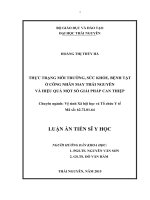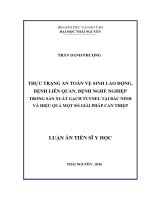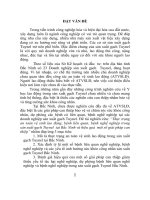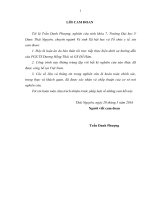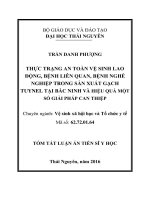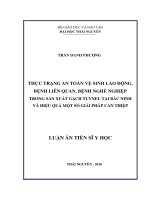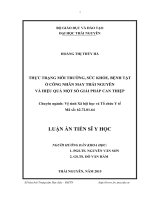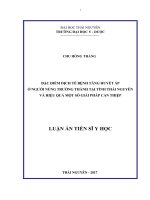Thực trạng cận thị ở học sinh tiểu học thành phố điện biên phủ và hiệu quả một số giải pháp can thiệp tt tiếng anh
Bạn đang xem bản rút gọn của tài liệu. Xem và tải ngay bản đầy đủ của tài liệu tại đây (665.44 KB, 28 trang )
MINISTRY OF EDUCATION
MINISTRY OF HEALTH
AND TRAINING
NATIONAL INSTITUTE OF HYGIENE AND EPIDEMIOLOGY
---------------------------------------
TRAN DUC NGHIA
THE STATUS OF MYOPIA IN PRIMARY SCHOOL
PUPILS IN DIEN BIEN PHU CITY AND THE
EFFECTIVENESS OF SOME INTERVENTION
SOLUTIONS
Major: Social Hygiene and Health Organization
Code: 62.72.01.64
SUMMARY OF MEDICAL PHD THESIS
HA NOI - 2019
1
THIS THESIS WAS COMPLETED
AT THE NATIONAL INSTITUTE OF HYGIENE AND EPIDEMIOLOGY
Supervisors:
1. Assoc. Prof. Nguyen Thi Thuy Duong, MD., PhD.
2. Assoc. Prof. Tran Van An, MD., PhD.
Opponent 1: ................................................ ..........
Opponent 2: .............................................. .........
Opponent 3: .............................................. ..........
The thesis will be defended in front of the Institute-level Dissertation
Assessment Committee at the National Institute of Hygiene and Epidemiology,
at …………,on………………… 2019
The thesis is available at:
1. The National Library of Vietnam
2. The Library of National Institute of Hygiene and Epidemiology
1
2
LIST OF PUBLICATIONS RELATED TO THE THESIS
1. Tran Duc Nghia, Nguyen Thi Thuy Duong, Tran Van An (2017), "Myopia in
primary school pupils in Dien Bien Phu city, 2016", Vietnam Journal of
Preventive Medicine, vol. 27, No. 9, p. 204-210.
2. Tran Duc Nghia, Tran Van An, Vu Duy Kien, Pham Phuong Lan, Pham Thi
Van Anh, Nguyen Thi Thuy Duong (2018), "Effectiveness of some intervention
activities to reduce the prevalence of myopia for primary school pupils in Dien
Bien Phu city, Dien Bien province (2016-2018)", Vietnam Journal of Preventive
Medicine, vol. 28, No. 11, p. 165-172.
2
3
INTRODUCTION
Myopia occurs when the eye is too focused as compared to the length of
the eyeball. This condition causes the object focus in front of the retina, so the
image of the object becomes blurred. It was estimated that in 2016, around 1.4
billion people worldwide had myopia, and it was equivalent to 22.9%, of the
world's population. Among people with myopia, about 163 million people (2.7%
of the world's population) suffered from severe myopia. In Asia, the prevalence
of school myopia has been increasing rapidly every year, and the school myopia
tends to spread in many countries.
Vietnam is one of the countries with a high prevalence of myopia, and
the prevalence of myopia tends to increase rapidly. In the report of blindness
prevention activities in 2006, it was shown that the prevalence of myopia among
school-age children in Vietnam ranged from 10% to 12% in rural areas, and
from 17% to 25% in urban areas. A recent study showed that the prevalence of
myopia reached 40% - 50% among pupils in urban areas.
Dien Bien Phu is a Class II city, which is directly under Dien Bien
province with an estimated population of 73,000 people in 2018. One-third of
the population in Dien Bien Phu city belongs to ethnic minority groups. Most of
Dien Bien Phu citizens live in urban areas (about 97% of the population). The
status of school myopia has been mentioned in several health reports of Dien
Bien Phu city. However, no study has been conducted to assess the status of
school myopia of pupils in Dien Bien Phu city. Furthermore, there is no
intervention in Dien Bien Phu city to reduce the prevalence of school myopia,
which is increasing in the area.
Providing information about myopia is very important because it will
contribute to strengthening health education activities about school myopia for
primary school pupils. Therefore, our research question is what the myopia
3
4
prevalence of primary school pupils in Dien Bien Phu city, Dien Bien is, and if
the status of myopia status is at an alarming level. What are the factors relating
to the myopia prevalence of primary school pupils? What intervention solutions
for preventing myopia can be effective in reducing the myopia prevalence
among primary school pupils.
To deal with our above issues, along with answering the research
questions we mentioned above, we conducted the study "The status of myopia
in primary school pupils in Dien Bien Phu city and the effectiveness of some
intervention solutions" with the following objectives:
1. To describe the status of myopia in primary school pupils and the
school hygiene status of in primary schools in Dien Bien Phu city in 2016.
2. To identify factors related to myopia in primary school pupils in Dien
Bien Phu city in 2016.
3. To evaluate the effectiveness of some myopia preventive solutions for
primary school pupils in Dien Bien Phu city, during 2016-2018.
NEW CONTRIBUTIONS AND PRACTICAL SCIENTIFIC
MEANINGS OF THE THESIS
This is the first study with the largest scope to learn about the status of
myopia in Dien Bien Phu city. Although the study site is a city, it is located in
mountainous areas with certain socioeconomic difficulties. The study provided
evidence about the prevalence of myopia and the tendency of the prevalence of
myopia by pupil grades in Dien Bien Phu city. Some limitations of school
hygiene conditions in primary schools in Dien Bien Phu city was found. The
study results also provide evidence associated factors with myopia among
primary school pupils in Dien Bien Phu city.
Within 18 months of intervention, the study showed the effective impact of
communication-based interventions and myopia preventive activities. Based on
4
5
the results, it would be the basis for the expansion of the intervention models for
all primary schools in Dien Bien Phu city, as well as other areas with the same
natural and socioeconomic conditions.
THE LAYOUT OF THE THESIS
The main content of the thesis consists of 103 pages with following
sections: Introduction (02 pages); Overview (28 pages); Methods (16 pages);
Results (28 pages); Discussion (26 pages); Conclusion (02 pages);
Recommendation (01 page). The thesis includes 36 tables, 11 figures (maps,
charts, diagrams) and 153 references (30 references in Vietnamese, 123
references in English), of which the number of references published in the last 5
year is 46/153 references, and related annexes.
Chapter 1 OVERVIEW
Myopia is a common refractive error of the eye. The people with myopia has
too high optical power as compared to the length of the eyeball axis. In the
myopia eye without modification, the light of the object to the eye focuses in
front of the retina, rather than directly on its surface. This causes the distant
object to be blurred, but nearby objects can be seen as normal. School myopia is
a term for children with myopia when they are at school-age. Myopia greatly
affects public health and social welfare. Myopia is considered as the leading
cause of vision impairment and blindness. People who are blind due to myopia
are burdens for families, society, and themselves.
Myopia is a common ophthalmic disease in the world. It is estimated that 1.4
billion people (22.9% of the world's population) had myopia, of which about
163 million people (2.7% of the world population) had severe myopia. The
burden of disease relating to myopia is expected to increase to 4.8 billion people
(50% of the world population), and an estimated 1 billion people with severe
5
6
myopia (about 10% of the world population) by 2050. In high-risk areas,
untreatable visual impairment is estimated to increase by 7 to 13 times in 2055.
Vietnam is one of the countries with myopia prevalence tends to grow
rapidly. In recent years, the myopia prevalence has increased rapidly not only in
urban areas but also in rural and mountainous areas. In 2006, according to
research by Thanh et al. in the preventive blindness activities report, the myopia
prevalence at school age in Vietnam was from 10% to 12% among pupils in
rural areas, and from 17% to 25% among pupils in urban areas. However, in
2014, the study by Hon et al. showed that the myopia prevalence in rural pupils
was from 10% to 15%, while it increased from 40 % to 50% among pupils in
urban areas.
The factors related to myopia are still being discussed. It is necessary to carry
out further studies to find out the risk factors that affect myopia because they
would have to deal with the increasing prevalence of myopia. Currently, there
are three main causes that associate with myopia, including genetic factors,
environmental factors, and other factors. In particular, school hygiene condition
is an important issue within the factors of environment because it impacts
directly on pupils. In addition, inappropriate living conditions and living habits
are also problems of environmental factors related to myopia.
Conducting health communication and education on the prevention of myopia
and eye diseases is one of the tasks regulated by the Ministry of Health. The
model of school-based health education and communication focuses on several
key contents, including the promotion of health education about common
diseases among pupils and providing knowledge about school myopia
prevention. For pupils, the school plays an important role in regularly
integrating health education content into teaching hours. The school also need to
organize myopia prevention activities regularly to form appropriate behaviors
for pupils. The content of eye disease prevention is also widely disseminated on
6
7
learning tools and stationery; thus, it can improve the knowledge of pupils and
their parents about myopia.
Chapter 2: STUDY SUBJECTS AND METHODS
2.1. Study subjects
Study subjects for the study to assess the status of myopia were primary
school pupils from grade 1 to grade 5. Study subjects for the study to explore the
associated factors with myopia were pupils in grade 4 and 5 of Be Van Dan and
Him Lam primary schools. Study subjects for the intervention study were pupils
in grade 3 and 4 of Him Lam primary school (intervention school) and Be Van
Dan (control school).
2.2. Study design
The study applied two main study designs, which were the crosssectional study design to understand the status of myopia and the associated
factors with myopia, and the community-based intervention study design,
including before-and-after evaluation and control.
2.3 Time and place
The time of the study was from April 2016 to April 2018. The whole
study was conducted in Dien Bien Phu City, Dien Bien Province.
2.4 Sample size
The sample size of the study on myopia status and on the associated
factors with myopia was estimated based on the formula of estimating a
population proportion with specified relative precision. This formula was
recommended by WHO, as follows:
2
n = Z1−α/2
p(1 − p)
×𝑘
(εp)2
(1)
where n is the minimum sample size that would be needed, p is the anticipated
prevalence, 𝑍1−α/2 is a confidence coefficient, 𝜀 is relative precision. For the
7
8
study to assess the status of myopia, the anticipated myopia prevalence was
used as 9.86% based on the result of a previous study, 𝑍1−α/2 was selected as
1.96 with 95% confidence level, and the relative precision of 15%. With k equal
to 2, applied the formula, the minimum sample size of 3.122 pupils would be
needed. In our study, we took the sample size of 4.757 pupils because this study
belonged to the provincial project. For the study to identify the associated
factors with myopia, the anticipated myopia prevalence of 16% (the myopia
prevalence was identified after the pilot study with 100 pupils), 𝑍1−α/2 was
selected as 1.96 with 95% confidence level, and the relative precision of 25%.
Applying the formula 1 without k, the sample size was estimated at 323 pupils.
Because the study was implemented by the class, so we collected a total of 402
pupils.
The sample size for the study on intervention is based on the formula of
estimating the difference between two population proportions. This formula was
recommended by WHO as follows:
n=
{Z1−α/2 √2p(1−p)+Z1−β √p1 (1−p1 )+p2 (1−p2 )}
(p1 −p2 )
2
(2)
Where, n is the minimum sample size for either intervention or control group
that would be needed, p1 is the anticipated myopia prevalence before the
intervention (based on the result from a pilot study), p2 is the anticipated myopia
prevalence before the intervention, p is the average change of the myopia
prevalence as p= (p1+ p2)/2, 𝑍1−α/2 equals to 1.96 (with the confidence level
of 95%),Z1−β = 0,84 (with the sample power of 80%). The sample size estimated
for each group was 260 pupils. In our study, 265 pupils from the intervention
group and 263 pupils from the control group with adequate information were
included in the analysis.
At each participating school, the research team selected one classroom,
which represents for each grade from grade 1 to 5. A total of 45 classrooms were
selected to our study from nine primary schools.
8
9
2.5. Intervention study
2.5.1. Identifying problems that need interventions
- School hygiene according to Vietnamese standards.
- The myopia status of pupils in Dien Bien Phu city.
- The study results about the associated factors with myopia.
- The ability to study population in response to the intervention solutions.
2.5.2 Intervention activities
The time of the study was from September 2016 to April 2018,
including two consecutive school-years. Excluding three months of summer
vacation, the total time of the intervention conducted at the school was 18
months. The study subjects of the intervention were primary school pupils at
grades 3 and 4 of Him Lam primary school. The contents of the intervention
include: 1) Changing awareness and behavior by direct communication and
distribution of leaflets; 2) Coordinating between the school and parents to
control the time of the eye concentration of pupils; 3) Providing guidance on
arranging study corners at home to ensure necessary conditions, 4)
Implementing the school hygiene measures based on the regulation; 5) Rotating
the position of pupils with opposite direction once a month.
2.6 Measurement of the effectiveness of the interventions
Using the Difference-in-Difference method to estimate the effectiveness
of the interventions on changing the outcome in the intervention group as
compared to that in the control group over a period of time. The intervention
effect on the myopia prevalence in this study was estimated based on the
difference-in-difference. The formula for estimating the variable different is as
follows:
DiD = (CT2 − C2 ) − (CT1 − C1 ) (3)
DiD is the difference-in-difference of the myopia prevalence (the impact
from intervention), CT1 is the myopia prevalence of the intervention group
before the intervention, C1 is the myopia prevalence of the control group before
9
10
the intervention, CT2 is the myopia prevalence of the intervention group after
intervention, C2 is the myopia prevalence of the control group at the time after
the intervention. After getting myopia, people cannot recover and often tend to
increase the magnitude of myopia. So, when applying formula 3, if the
intervention is effective, the value of DiD will be negative, which means that
intervention has helped to prevent the increase of the myopia prevalence in the
intervention group as compared to the control group.
2.7. Data collection.
Tools and equipment for data collection included: The Landolt broken
ring, the glass box with different glass numbers, the form for eyesight
examination, the questionnaires for pupils, the meter tape with the accuracy of 1
cm, the Luxmetre machine, the school hygiene checklist. Data collection
activities were conducted by the research team included: checking eyesight and
collecting relating information, interviewing pupils about knowledge and habits
relating to myopia, conducting an assessment on school hygiene conditions and
collecting data after the intervention.
2.8. Errors and solutions to control errors
To control the errors of data collection about the diagnosis of myopia,
all the doctors who participated in the study agreed on the procedure of
examination and final conclusion. The data collectors were selected and trained
to understand the questionnaires. The data entry form was designed by Epidata
software with appropriate algorithms to avoid errors.
2.9 Data management and analysis
Data were entered and managed by Epidata software version 3.1. Data
then were cleaned and analyzed by the STATA software version 14. Descriptive
statistics and analysis methods were used. The intervention effect was estimated
based on the analysis of difference-in-difference. The statistical significance
level used was p <0.05.
10
11
2.10 Ethical consideration
The study was approved by the Ethical Committee for Biomedical
Research at the National Institute of Hygiene and Epidemiology before
conducting research at the document no. CT:IRB - VN 01057-37/ 2016 dated
October 6th, 2016.
Chapter 3: RESULTS
3.1. The status of myopia and school hygiene conditions
3.1.1 Characteristics of the study subjects
Table 3.1. Distribution of study subjects by school and sex
Primary school
Hanoi- Dien Bien Phu
Nam Thanh
Him Lam
Be Van Dan
To Vinh Dien
Hoang Van No
Thanh Minh
Thanh Truong
Noong Bua
Total
n
910
614
883
879
614
101
114
275
367
4757
Male
N
467
362
492
505
337
51
56
131
183
2584
%
52.3
58.9
55.7
57.4
54.8
50.5
49.1
47.6
49.8
54.3
Female
N
Ratio %
443
47.7
252
41.1
391
44.3
374
42.6
277
45.2
50
49.5
58
50.9
144
52.4
184
50.2
2173
45.7
A total of 4,757 pupils was enrolled in the study, including 2,584 males
(54.3%) and 2,173 females (45.7%). Hanoi-Dien Bien Phu primary school had
the largest number of pupils (910 pupils), followed by Him Lam Primary School
(883 pupils) and Be Van Dan (879 pupils). The lowest number of pupils was at
Hoang Van No primary school (101 pupils).
11
12
Figure 3.1: Distribution of study subjects by ethnic groups
The majority of pupils in the study were Kinh, accounting for 83.3%.
Thai ethnic pupils also account for a significant proportion (14.2%). All pupils
from other ethnic groups, including H'mong, Kho Mu, Ha Nhi, etc., accounted
for a small percentage (2.5%).
3.1.2. The status of myopia situation in primary school pupils
Table 3.2. The percentage of primary school pupils with myopia by school
Primary school
Hanoi- Dien Bien Phu
Nam Thanh
Him Lam
Be Van Dan
To Vinh Dien
Hoang Van No
Thanh Minh
Thanh Truong
Noong Bua
Total
Myopia
n
910
614
883
879
614
101
114
275
367
4.757
12
N
247
106
137
140
125
0
0
20
43
818
%
27.1
17.2
15.5
15.9
20.3
0
0
7.2
11.7
17.2
13
Out of 4,757 pupils participating in the study, 818 pupils were found
with myopia, accounting for 17.2% (Table 3.2). Pupils with myopia in primary
schools in Hanoi - Dien Bien Phu (27.1%) accounted for the highest prevalence,
followed by pupils of To Vinh Dien primary school (20.3%) and Nam Thanh
primary school (17.2%). There were no myopia pupils in Hoang Van No and
Thanh Minh primary schools (Table 3.2).
Table 3.3. The myopia prevalence of pupils by grade
Grade
Myopia
Total
N
%
Grade 1
955
99
10.3
Grade 2
960
95
9.8
Grade 3
1013
182
17.9
Grade 4
958
209
21.8
Grade 5
871
233
26.7
4,757
818
17.2
Total
The myopia prevalence of pupils by grade is presented in Table 3.3. In
general, the myopia prevalence of pupils tends to increase from the low grade to
the higher grade, ranging from 9.8% to 26.7%. In the lower grades (grade1 and
2), myopia rate was only about 10%. However, for pupils in grade 5, the
myopia prevalence increased to 26.7%.
Table 3.4. The myopia prevalence of pupils by the level of myopia
Level of myopia
N
%
Mild (<3 Diop)
671
82,0
131
16,0
Moderate (3 - 6 Diop)
Severe (> 6 Diop)
16
2,0
Total
818
100
Table 3.4 shows that out of 818 myopia pupils, the myopia pupils with
mild degree accounted for 82%, while the moderate level was 16%. The severe
myopia accounted for only 2% of the total number of pupils with myopia.
13
14
Table 3.5. The myopia prevalence of pupils by myopia features
Myopia features
Myopia in 1 eye
Myopia in 2 eyes
Total
N
113
705
818
%
13.8
86.2
100
Out of 818 cases recorded with myopia, 705 cases got myopia with both
eyes, accounting for 86.2%. In addition, there were 113 cases with only myopia
in one eye, accounting for 13.8% (Table 3.5).
3.1.3. The status of school hygiene condition of primary schools
In the study, a total of 45 classrooms were enrolled, each representing
one grade between grade 1 to grade 5, which were from nine participating
schools. For criteria on class size (length ≤8.5m, width≤ 6.5m, height ≤3.5m),
34/45 of classrooms met the standard of class sizes. Only 20/45 of classrooms
met the standard of the distance between the first table and the board.
Especially, only 1/45 of the classroom met the standard for the last table
distance to the board; this distance must be less than or equal to 8m (Table 3.6).
Table 3.6. School hygiene conditions for classrooms
Criteria
Room
size
(length8.5m,
Width6.5m,height3.6m)
Distance between the first table to board (1.7-2m)
Distance from the last table to the board (8m)
Distance between the table and chair ( 20-25cm)
Board
- Size: length 1.8-2m, width 1.2-1.5m
- Color : Green or Black
- Hanging on mid-wall, above floor: 0,8-1m
All criteria
Meet the standard (n=45)
N (%)
34 (75.6)
20 (44.4)
1 (2.2)
9 (20.0)
45 (100)
1 (2.2)
Only 9/45 of classrooms met the standard for distance between tables
and chairs. For the standard of the board, 100% of the classes met the
requirements. For all criteria, only 2.2% (1/45) of the classes met the
requirements.
14
15
3.2. Myopia and associated factors
3.2.1. Association between myopia and pupil habits
A total of 402 pupils participated in the study to find out the associated
factor with myopia. The proportion of male pupils was 42.5%, while the
proportion of female pupils was 57.5%. All pupils in the study were in grades 4
and 5, of which the proportion of grade 4 and 5 pupils was 49% and 51%,
respectively.
Table 3.7. Factors associated with pupil myopia (multivariable analysis)
Independent variable
Parents had myopia
Yes
No
Study extra-classes continuously >1 hour
Yes
No
Use the computer continuously >1 hour
Yes
No
Watch TV continuously >1 hour
Yes
No
Play computer games continuously >1
hour
Yes
No
Adjusted
OR
CI 95%
p value
2.67
1
1.45-4.91
<0.01
2.48
1
1.34-4.61
<0.01
2.25
1
1.13-4.49
0.02
1.38
1
0.70-2.73
0.35
2.38
1
1.12-5.03
<0.01
The results of multivariable analysis between myopia and some
associated factors are presented in Table 3.7. Parents with myopia, studying
extra-classes continuously more than 1 hour, using computers continuously for
more than 1 hour and playing computer games continuously for more than 1
hour associated with myopia. In detail, pupils who had parents with myopia
were 2.67 times more likely to get myopia compared to pupils who had parents
without myopia (p<0.01). Pupils who studied in extra-classes continuously for
more than 1 hour were 2.48 times more likely to get myopia compared to pupils
who did not study in extra-classes continuously more than 1 hour (p <0.01).
Pupils who used computers continuously for more than 1 hour were 2.25 times
15
16
more likely to get myopia than pupils who did not use computers continuously
for more than 1 hour (p = 0.02). Pupils who played video games continuously
for more than 1 hour were 2.38 more likely to get myopia than pupils who did
not play video games continuously for more than 1 hour (p <0.01). In the
multivariate regression model, watching TV continuously for more than 1 hour
had no association with myopia (p = 0.35).
3.3. Evaluation of intervention solutions
3.3.1. Intervention activities and results
Table 3.8. Intervention activities at Him Lam primary school
Intervention activities
Target population
Frequency
Workshop: School myopia,
preventive measures and treatment
Communication: Myopia, causes,
consequences and prevention of
myopia.
Guidance on how to arrange the study
corner for pupils.
Guidance on how to control the time
the eye has to work focused
Delivery leaflets: How to detect and
prevent some common eye diseases.
Teacher of Him Lam
1 session
Primary School
Leaders of the city's 1 session
education
department,
parents, teachers and all
pupils of Him Lam
primary school
Guidance on how to detect
abnormalities of eyes: Equipping the
vision testing chart and instructing
the school health staff on how to test
eyesight
and
detect
vision
abnormalities for pupils
Guidance on the frequent changing
position of pupils in the classroom:
once a month
Medical staff at Him Lam 01 vision
Primary School
testing
chart
Guidance: ensuring school hygiene
conditions
Pupils and parents of Him 500 leaflets
Lam primary school
Homeroom teacher and 1 session
pupils of Him Lam
primary school in grade 3
and 4
Representatives of the 1 session
Education
Department,
school administrators, key
staff of Him Lam primary
school
16
17
The intervention activities were implemented as planned. Workshops,
communication, and distribution of leaflets had direct impact on local pupils,
parents, teachers and local education authorities. Moreover, the school's health
staff were trained and improved knowledge of early detection of myopia for
pupils. The homeroom teachers were instructed on how to change pupils'
positions in the classroom and committed to doing so. School administrators and
key staff were instructed to ensure that school hygiene conditions are in
accordance with regulations (Table 3.8).
3.3.2. General characteristics of study subjects
Table 3.9. Demographic characteristics of study subjects
Sex
Male
Female
Grade
3rd to 4th
4th to 5th
Intervention (n=263)
N (%)
Control (n=265)
N (%)
p value
142 (54.0)
121 (46.0)
148 (55.9)
117 (44.2)
0.67
131 (49.8)
132 (50.2)
118 (44.5)
147 (55.5)
0.22
Table 3.9 shows the demographic characteristics of participants in the
intervention study with a total of 263 pupils in the intervention group, and 265
pupils in the control group. Regarding gender, the proportion between male and
female pupils did not differ significantly in both the intervention group and the
control group (p = 0.67). For the grade level, the percentage of pupils in the
grade levels was relatively similar, and there was no significant difference (p =
0.22).
3.3.3 Impact of the interventions
Table 3.10. The myopia prevalence before and after the intervention
Intervention group (n=263)
Control group (n=265)
N (%)
N (%)
Before
After
intervention intervention
p
17
Before
After
intervention intervention
p
18
Sex
Male
27 (19.0)
33 (22.9)
0.42
24 (16.2)
43 (30.7)
<0.01
Female
16 (13.2)
19 (16.0)
0.55
21 (17.9)
38 (30.4)
0.02
3rd to 4th
19 (14.5)
21 (16.0)
0.73
15 (12.7)
29 (24.6)
0.02
4th to 5th
24 (18.2)
31 (23.5)
0.29
30 (20.4)
52 (35.4)
<0.01
43 (16.4)
52 (19.8)
0.31
45 (17.0)
81 (30.6)
<0.01
Grade
Total
Table 3.10 shows the myopia prevalence of the intervention and control group
before and after the intervention. In the intervention group, the myopia
prevalence increased after the intervention as compared to before intervention,
but the difference was not statistically significant (all values p> 0.05).
Meanwhile, in the control group, the myopia prevalence increased significantly
between before and after the intervention, the difference was statistically
significant (all values p <0.05).
Table 3.11. Intervention impact estimated by difference-in-difference
Myopia
N (%)
p value
Before Intervention
Control group (n=265)
45 (17.0)
Intervention group (n=263)
43 (16.4)
Difference (Intervention - Control) (%)
-0.6
0.86
After Intervention
Control group (n=265)
52 (30.6)
Intervention group (n=263)
81 (19.8)
Difference (Intervention - Control) (%)
-10.8
<0.01
Difference-in-difference (DiD) (%)
-10.2
0.04
Table 3.11 shows the estimation of differences and difference-indifference between the intervention and control groups before and after the
intervention. The myopia prevalence of the intervention group (16.4%) and the
18
19
control group (17.0%) at the time before the intervention were relatively similar,
and there was no significant difference (p = 0,86). The myopia prevalence in the
control group (30.6%) has increased significantly as compared to the
intervention group (19.8%), the difference is 10.8%, and it was statistically
significant (p <0.01. According to the results, the difference-in-difference of the
intervention was estimated to be -10.2%, and it was statistically significant (p =
0.04).
Chapter 4: DISCUSSION
4.1. The status of myopia and school hygiene conditions
Vision examination for 4,757 students of 9 primary schools in Dien
Bien Phu city, we found that the number of myopia pupils in primary school
students was 818 pupils, accounting for 17.2%. Comparing to previous studies
in Vietnam, the school myopia prevalence in primary school pupils in Dien Bien
Phu city was higher than that in studies in other provinces or cities. According to
study results of Nga et al. in three regions of Hai Phong, Thai Nguyen and Ho
Chi Minh city, the myopia prevalence of primary school children was 6.9%.
Similarly, the myopia prevalence in our study was higher than that in the study
conducted by Dung et al. in Thai Nguyen (16.8%). In our study, although the
overall myopia prevalence was 17.2%, the myopia prevalence was different
between schools. The high myopia prevalence concentrated in the central
primary schools, two surrounding primary schools had no case of myopia, thus,
if excluding these two primary schools, the myopia prevalence of pupils in the
central areas would be 18%.
The number of myopia pupils in our study was 818 pupils, of which
pupils with two-eyed myopia were 705 pupils, accounting for a high proportion
of 86.2%. The number of pupils with either right or left eye myopia was 113
pupils, accounting for 13.8%. However, one-eye myopia is much more harmful
than myopia in both eyes. For one-eye myopia, the eye with myopia would not
involve in the vision process, and the retinal receptor cells become lazy to work,
19
20
leading to amblyopia due to refractive errors. If the situation of amblyopia is not
detected and treated, the eye will not recover.
When conducting the analysis of myopia by grade level, our study
shows that the myopia prevalence of primary school pupils tended to increase
gradually from low to high grades. The myopia prevalence of grade 1 and 2
were only 10.3% and 9.8%, but the myopia prevalence reached to 26.7% in the
5th grade pupils. The results of the study showed that the higher the class, the
higher the myopia prevalence, or the greater the age of primary school pupils,
the higher myopia prevalence (equivalent to the age of pupils from 6 to 10 years
old). This result was consistent with some other studies in the world.
School hygiene conditions play an important role in pupils' health and
learning ability. In particular, several criteria for school hygiene conditions
affect and directly relate to school myopia. All classrooms assessed in our study
met the requirements of classrooms area per pupil. However, regarding the size
of classes, only 75.6% of the classrooms met criteria. Especially, the criteria for
distance from the last table to the board met the requirement by only 1/45 of the
classroom, in particular, most of the classes had the distance from the last table
to the board larger than 8m. The distance from the last table to the board would
make pupils' eyes work harder, affecting their eyesight.
In our study, only 9/24 (20%) of the classrooms qualified for the
difference between desks and chairs. Most of the schools invested in their
facility, but the synchronization between table and chair in the classroom was
not high. Classroom lighting is also an important factor because it affected
directly to the eyesight of pupils. If the lighting conditions are good, the ability
and efficiency of the eye are higher. Pupils need to regulate their eyes more in
case of the lighting of the classroom is inadequate. However, in our study, only
35/45 (77.8%) of the classrooms met the requirements for the lighting of the
classroom.
20
21
4.2. Factors associated with the myopia of primary pupils
Identifying factors relating to the myopia of pupils plays an important
role in providing appropriate interventions for pupils. Different groups of pupils
and regions have different characteristics and habits relating to their probability
to get myopia. In our study, there was an association between myopia and some
habits of pupils, including study in extra-classes continuously more than one
hour, use of computers continuously more than one hour, and playing computer
game continuously more than one hour. Also, myopia in primary school pupils
also associated with the parents' myopia. This is scientific evidence that helps
local policymakers to develop appropriate interventions for primary school
pupils.
Our research shows that there was a close association between
studying in extra-classes and myopia. Accordingly, pupils who took extraclasses were 1.72 times more likely to get myopia than those who did not take
extra-classes. Moreover, pupils who studied in extra-classes continuously more
than one hour were 2.48 times more likely to get myopia (multivariate
regression models) than those who did not. The results of our study were
consistent with previous studies when they indicated that myopia pupils often
spent more time on learning than those who did not. According to the findings
by An et al. at Thang Long University in 2013 - 2014, pupils studied more than
10 hours per week were 1.96 times more likely to get myopia than pupils who
did not. In the study by Dung et al., pupils who studied more than five hours per
day were 3.2 times more likely to get myopia than those who studied less than
two hours per day. In our study, the evaluation of the extra-classes was different
from other studies because our study subjects were primary school pupils.
Actually, primary school pupils would need to study less than pupils in high
school or university. Also, the way that the primary school pupils spending time
on studying was different from pupils at more likely education levels.
21
22
The work that requires close and continuous working of eyes is
considered to be an important risk factor affecting the development of myopia.
Using computers, watching television, playing electronic games, and reading
storybooks are activities that make the eyes saw close-up continuously.
However, different groups of people and different ways of exposure to these risk
factors can lead to different myopia prevalence. Some studies found that there
was an association between myopia and the use of the computer, watching
television, playing electronic games, and reading storybooks. Many authors
reported that reading, writing, and using computers regularly for a long-time
lead to the more likely myopia prevalence.
In our univariate and multivariate analysis, we found that there was an
association between myopia in pupils and the myopia status of their parents.
Many studies showed that there was an association between myopia in parents
and children. This may be partly due to genetic factors. However, there may also
be a combination of bad habits that children learned from their parents. For
parents with myopia, more attention should be paid to prevent myopia for their
children. In particular, it is necessary to understand the myopia manifestations to
detect the abnormalities of the eyes early and take children for examination and
getting advice from doctors.
4.3. Effectiveness of interventions for school pupil myopia
During the 18-month intervention period, all intervention activities were
completed and ensured according to the plan. Workshop on preventive and
treatment measures for school myopia was implemented for all teachers of Him
Lam primary school. We also held a communication session on myopia for
leaders of the city's education department, parents, teachers, and all pupils of
Him Lam primary school. Pupils were given leaflets with basic knowledge about
myopia prevention. In particular, we collaborated with teachers to plan and
implement the rotation of pupils' sitting positions in the classroom. School
health staff were instructed on how to examine and detect suspected cases of
22
23
myopia. The key staff of the school was discussed and instructed how to ensure
school hygiene conditions at the school.
After the intervention period, we found a significant improvement in the
indicators of school hygiene conditions at the intervention schools. Most of the
school hygiene indicators met the standards of the Ministry of Health. In
particular, all of the classes at the school improved the lighting conditions and
the criteria of the difference between desks and chairs. Meanwhile, in the control
primary school, the indicators of school hygiene conditions were almost
unchanged. This result was also consistent with some other intervention studies.
This demonstrates that the intervention solution was feasible and able to be
conducted if the schools would pay more attention.
The post-intervention assessment was conducted after the intervention time in
both intervention school (Him Lam) and control school (Be Van Dan). The
myopia prevalence before and after intervention in both the intervention group
and the control group increased at the time of the post-intervention assessment.
However, the myopia prevalence in the control group increased more than that
in the intervention group. The difference-in-difference was calculated as -10.2%
(p = 0.04), meaning that the intervention helped to prevent the increase of the
myopia prevalence about 10.2%. The results of this study will be evidence to
help policymakers provide appropriate interventions to expand the model of
school myopia prevention in Dien Bien Phu city. The difference-in-difference
method to evaluate the effectiveness of the interventions was recommended by
WHO, and it has been used in many biomedical studies. The difference-indifference method is recommended because it can help determine the
effectiveness of the interventions after a period of interventions.
23
24
CONCLUSION
1. The status of myopia and school hygiene conditions
- The myopia prevalence of primary pupils in Dien Bien Phu city was 17.2%.
Among the myopia pupils (818 cases), the proportion of pupils had mild,
moderate and severe myopia were 82%, 16% and 2%, respectively.
- The myopia prevalence was no difference between male and female pupils.
- The myopia prevalence tended to increase gradually from grade 1 to grade 5,
from 10.3% in grade 1 to 26.7% in grade 5.
- Among myopia pupils, 13.8% of pupils had myopia in only one eye, 86.2%
had myopia in both eyes.
- The number of classrooms that met the standard of class sizes was 75.6%, but
only 44.4% of classrooms met the standard of distance from the first table to the
board. Only 2.2% of classroom met the standard of the distance from the last
table to the board.
- The proportion of classrooms met the requirements on the difference between
desks and chairs was 20%.
- For the standard of the classroom lighting, only 77.8% of the classrooms met
the requirement.
2. Factors associated with the myopia of primary pupils
- Pupils whose parents had myopia were 2.67 times more likely to get myopia
than those with parents who did not have myopia.
- Pupils who studied in extra-classes continuously more than one hour were 2.48
times more likely to get myopia than those who studied in extra-classes
continuously less than one hour.
- Pupils who used computers continuously more than one hour were 2.25 times
more likely to get myopia than those who did not use computers continuously
for more than one hour.
24
